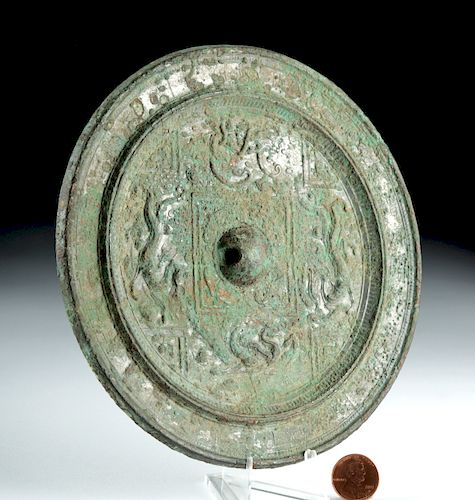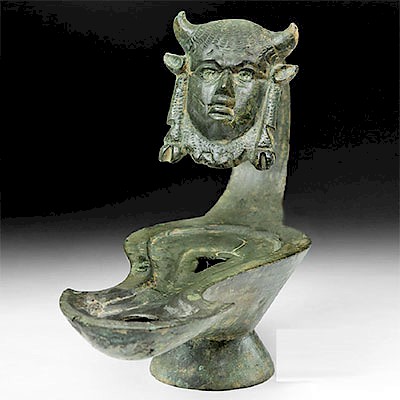Chinese Tang Dynasty Bronze Mirror
Lot 115
About Seller
Artemis Gallery
686 S Taylor Ave, Ste 106
Louisville, CO 80027
United States
Selling antiquities, ancient and ethnographic art online since 1993, Artemis Gallery specializes in Classical Antiquities (Egyptian, Greek, Roman, Near Eastern), Asian, Pre-Columbian, African / Tribal / Oceanographic art. Our extensive inventory includes pottery, stone, metal, wood, glass and textil...Read more
Estimate:
$900 - $1,400
Absentee vs Live bid
Two ways to bid:
- Leave a max absentee bid and the platform will bid on your behalf up to your maximum bid during the live auction.
- Bid live during the auction and your bids will be submitted real-time to the auctioneer.
Bid Increments
| Price | Bid Increment |
|---|---|
| $0 | $25 |
| $300 | $50 |
| $1,000 | $100 |
| $2,000 | $250 |
| $5,000 | $500 |
| $10,000 | $1,000 |
| $20,000 | $2,500 |
| $50,000 | $5,000 |
| $100,000 | $10,000 |
| $200,000 | $20,000 |
About Auction
By Artemis Gallery
Sep 27, 2018
Set Reminder
2018-09-27 10:00:00
2018-09-27 10:00:00
America/New_York
Bidsquare
Bidsquare : Antiquities | Asian | Ethnographic
https://www.bidsquare.com/auctions/artemis-gallery/antiquities-asian-ethnographic-3469
Featuring classical antiquities, ancient and ethnographic art from cultures encompassing the globe. Artemis Gallery info@artemisgallery.com
Featuring classical antiquities, ancient and ethnographic art from cultures encompassing the globe. Artemis Gallery info@artemisgallery.com
- Lot Description
East Asia, China, Tang Dynasty, ca. 618 to 907 CE, probably early in the period, ca. 7th to 8th century CE. A perfectly round mirror made of bronze with a high tin content to give it a silvery appearance. The back is finely decorated with a ring of Chinese characters (based on other known examples of Tang mirrors, these probably are incantations or prayers), and a further interior ring with four animals. The back is pierced for suspension through a rounded central knob, and we know that a cord would have been threaded through the hole to make it easier to hold or carry. A mirror of this size could be easily carried inside of a sleeve for easy use throughout the day. Analysis of a similar mirror from the Freer Gallery of the Smithsonian found traces of silk imprinted upon the back of the mirror, leading researchers there to conclude that these mirrors would have been stored in silk pouches when not in use. Size: 6.45" W (16.4 cm)
Mirrors in ancient China served both practical and spiritual purposes. Bronze mirrors were also luxury goods that would have been expensive to produce and therefore to buy. During the Tang Dynasty, we see the first private workshops beginning, allowing the rising merchant class to purchase mirrors in addition to nobles. When placed in a tomb upon the chest of the deceased, as they often were, they were meant to protect the dead from evil spirits, who were frightened of being seen in reflection. In a similarly symbolic move, women carried "marriage mirrors" on their laps during their wedding procession; these were later hung over the marriage bed to repel evil spirits.
Provenance: ex-Wong collection, Lotus Trading, acquired around 1974
All items legal to buy/sell under U.S. Statute covering cultural patrimony Code 2600, CHAPTER 14, and are guaranteed to be as described or your money back.
A Certificate of Authenticity will accompany all winning bids.
We ship worldwide and handle all shipping in-house for your convenience.
#137925Mottled patina on surface, with most of the motifs still visible.Condition
- Shipping Info
-
All shipping is handled in-house for your convenience. Your invoice from Artemis Gallery will include shipping calculation instructions. If in doubt, please inquire BEFORE bidding for estimated shipping costs for individual items.
-
- Buyer's Premium



 EUR
EUR CAD
CAD AUD
AUD GBP
GBP MXN
MXN HKD
HKD CNY
CNY MYR
MYR SEK
SEK SGD
SGD CHF
CHF THB
THB













